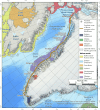Greenland Norse walrus exploitation deep into the Arctic
- PMID: 39331710
- PMCID: PMC11430631
- DOI: 10.1126/sciadv.adq4127
Greenland Norse walrus exploitation deep into the Arctic
Abstract
Walrus ivory was a prized commodity in medieval Europe and was supplied by Norse intermediaries who expanded across the North Atlantic, establishing settlements in Iceland and Greenland. However, the precise sources of the traded ivory have long remained unclear, raising important questions about the sustainability of commercial walrus harvesting, the extent to which Greenland Norse were able to continue mounting their own long-range hunting expeditions, and the degree to which they relied on trading ivory with the various Arctic Indigenous peoples that they were starting to encounter. We use high-resolution genomic sourcing methods to track walrus artifacts back to specific hunting grounds, demonstrating that Greenland Norse obtained ivory from High Arctic waters, especially the North Water Polynya, and possibly from the interior Canadian Arctic. These results substantially expand the assumed range of Greenland Norse ivory harvesting activities and support intriguing archaeological evidence for substantive interactions with Thule Inuit, plus possible encounters with Tuniit (Late Dorset Pre-Inuit).
Figures






References
-
- Friesen T. M., Arnold C. D., The timing of the Thule migration: New dates from the western Canadian Arctic. Am. Antiq. 73, 527–538 (2008).
-
- P. Schledermann, A.D. 1000: East Meets West, in Vikings: The North Atlantic Saga, W. W. Fitzhugh, E. I. Ward, Eds. (Smithsonian Institution Press, 2000), pp. 189–192.
-
- J. Arneborg, The Norse settlements in Greenland, in The Viking World (Routledge, 2008), pp. 612–627.
-
- Friesen T. M., Finkelstein S. A., Medeiros A. S., Climate variability of the Common Era (AD 1–2000) in the eastern North American Arctic: Impacts on human migrations. Quat. Int. 549, 142–154 (2020).
-
- McGhee R., Contact between native North Americans and the medieval Norse: A review of the evidence. Am. Antiq. 49, 4–26 (1984).
MeSH terms
LinkOut - more resources
Full Text Sources
Other Literature Sources

